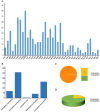Mitochondrial genome assembly of the Chinese endemic species of Camellia luteoflora and revealing its repetitive sequence mediated recombination, codon preferences and MTPTs
- PMID: 40186100
- PMCID: PMC11971748
- DOI: 10.1186/s12870-025-06461-6
Mitochondrial genome assembly of the Chinese endemic species of Camellia luteoflora and revealing its repetitive sequence mediated recombination, codon preferences and MTPTs
Abstract
Camellia luteoflora Y.K. Li ex Hung T. Chang & F.A. Zeng belongs to the Camellia L. genus (Theaceae Mirb.). As an endemic, rare, and critically endangered species in China, it holds significant ornamental and economic value, garnering global attention due to its ecological rarity. Despite its conservation importance, genomic investigations on this species remain limited, particularly in organelle genomics, hindering progress in phylogenetic classification and population identification. In this study, we employed high-throughput sequencing to assemble the first complete mitochondrial genome of C. luteoflora and reannotated its chloroplast genome. Through integrated bioinformatics analyses, we systematically characterized the mitochondrial genome's structural organization, gene content, interorganellar DNA transfer, sequence variation, and evolutionary relationships.Key findings revealed a circular mitochondrial genome spanning 587,847 bp with a GC content of 44.63%. The genome harbors70 unique functional genes, including 40 protein-coding genes (PCGs), 27 tRNA genes, and 3 rRNA genes. Notably, 9 PCGs contained 22 intronic regions. Codon usage analysis demonstrated a pronounced A/U bias in synonymous codon selection. Structural features included 506 dispersed repeats and 240 simple sequence repeats. Comparative genomics identified 19 chloroplast-derived transfer events, contributing 29,534 bp (3.77% of total mitochondrial DNA). RNA editing prediction revealed 539 C-to-T conversion events across PCGs. Phylogenetic reconstruction using mitochondrial PCGs positioned C. luteoflora in closest evolutionary proximity to Camellia sinensis var. sinensis. Selection pressure analysis (Ka/Ks ratios < 1 for 11 PCGs) and nucleotide diversity assessment (Pi values: 0-0.00711) indicated strong purifying selection and low sequence divergence.This study provides the first comprehensive mitochondrial genomic resource for C. luteoflora, offering critical insights for germplasm conservation, comparative organelle genomics, phylogenetic resolution, and evolutionary adaptation studies in Camellia species.
Keywords: Camellia luteoflora; Homologous recombination; Mitochondrial genome; RNA editing events.
© 2025. The Author(s).
Conflict of interest statement
Declarations. Ethics approval and consent to participate: The plant materials collected in this study are in accordance with international and national legal standards. The collected plant material does not pose a threat to other species and the collection of the species was recognized by the relevant authorities. The collected material was not subjected to medical experiments and only chloroplast and mitochondrial genes were extracted from the plant material. Consent for publication: Not applicable. Competing interests: The authors declare no competing interests.
Figures










Similar articles
-
Complete sequencing of the mitochondrial genome of tea plant Camellia sinensis cv. 'Baihaozao': multichromosomal structure, phylogenetic relationships, and adaptive evolutionary analysis.Front Plant Sci. 2025 Jun 13;16:1604404. doi: 10.3389/fpls.2025.1604404. eCollection 2025. Front Plant Sci. 2025. PMID: 40584852 Free PMC article.
-
Comparative analysis of the whole mitochondrial genomes of four species in sect. Chrysantha (Camellia L.), endemic taxa in China.BMC Plant Biol. 2024 Oct 12;24(1):955. doi: 10.1186/s12870-024-05673-6. BMC Plant Biol. 2024. PMID: 39395971 Free PMC article.
-
Assembly and analysis of the complete mitochondrial genome of an endemic Camellia species of China, Camellia tachangensis.BMC Genomics. 2025 May 15;26(1):490. doi: 10.1186/s12864-025-11673-z. BMC Genomics. 2025. PMID: 40375169 Free PMC article.
-
Decoding the complete mitochondrial genome of Hydrangea chinensis maxim.: insights into genomic recombination, gene transfer, and RNA editing dynamics.BMC Plant Biol. 2025 Aug 16;25(1):1078. doi: 10.1186/s12870-025-07119-z. BMC Plant Biol. 2025. PMID: 40817245 Free PMC article.
-
Complete mitochondrial genome assembly and comparison of Camellia sinensis var. Assamica cv. Duntsa.Front Plant Sci. 2023 Jan 19;14:1117002. doi: 10.3389/fpls.2023.1117002. eCollection 2023. Front Plant Sci. 2023. PMID: 36743486 Free PMC article.
References
-
- Zhang HD, Zeng FA. Camellia L. new group sect. Luteoflora Chang. Acta Scientiarum Naturalium Universitatis Sunyatseni. 1982; (3):74–5.
-
- Zou TC. Inquire into species origin of Camellia luteoflora Y. K. Li, an endemic species in Guizhou. J Guizhou Normal Univ (Social Science). 2002;20(1):6–10.
-
- He QQ. The distribution pattern of Camellia Luteofora Y.K. Li population. Environ Prot Technol. 2012;18(3):28–30.
-
- Chen F, Wang X. Camellia luteoflora Li ex Chang, A newly recorded species of theaceae from Sichuan Province. J Fujian Forestry Sci Technol. 2016;43(4):167–8.
-
- Liu QB, Liu BY, Liang S. Discussion on the endangered causes and countermeasures of Camellia Luteofora. Environ Prot Technol. 2005;11(3):18–20.
MeSH terms
Grants and funding
LinkOut - more resources
Full Text Sources
Research Materials
Miscellaneous

